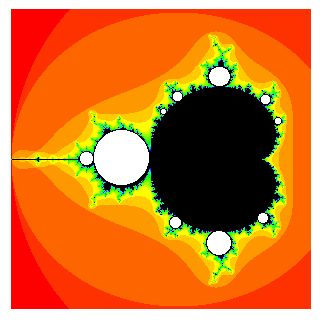
In these animations we test your knowledge about the dynamics and geometry of the Mandelbrot set. If you are unfamiliar with the Mandelbrot set, you should first peruse the article entitled "The Fractal Geometry of the Mandelbrot set: I. The Periods of the Bulbs" Better yet, you can take an interactive tour of the Mandelbrot set and the associated Julia sets by visiting the Mandelbrot Set Explorer.
If you already know something about the Mandelbrot and Julia sets, then you may test your knowledge by figuring out why we name the bulbs or decorations as we do. Each highlighted decoration in the Mandelbrot set has a name. Your job is to figure out why this decoration is so named. Click on the decoration (the white highlighted disk). You will first see a magnification of that bulb or decoration. Then click on the QT icon to see the Julia set for a given c-value in the bulb. Superimposed on this bulb is the attracting cycle to which the orbit of 0 tends. By activating the movie feature, you will see the behavior of this orbit.
Your question is: Why do we call this the p/q bulb? There are actually three different answers to this question. See if you can figure out all three.
To find out why these bulbs are so named, consult "The Fractal Geometry of the Mandelbrot set: II. How to Count and How to Add"

(Return to Dynamical Systems and Technology Page)
(Return to Bob Devaney'sHome Page)